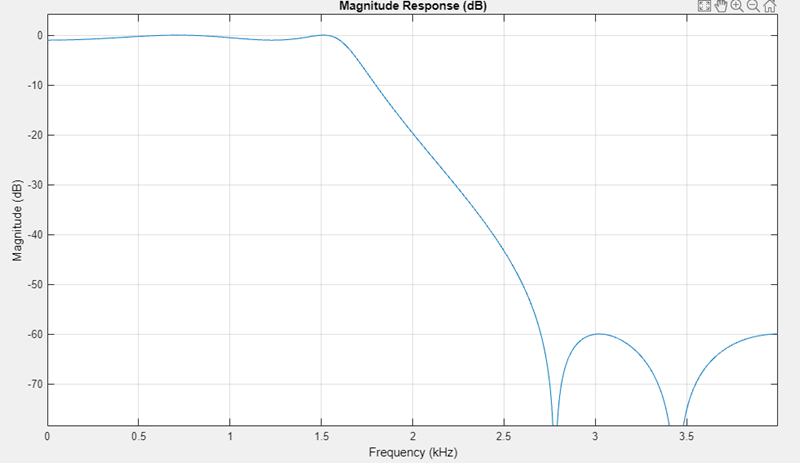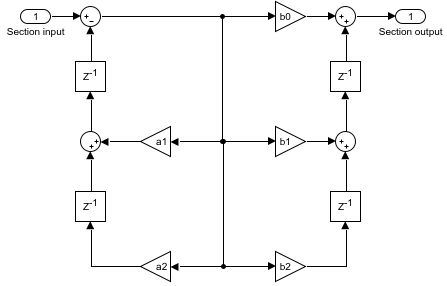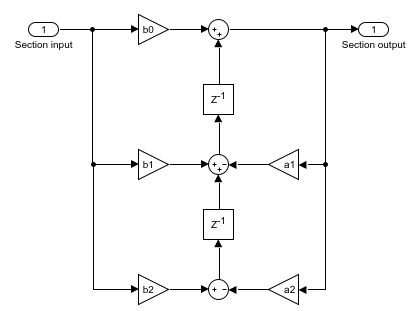dsp.BiquadFilter
(削除予定) 双二次構造を使用した IIR フィルター
dsp.BiquadFilter オブジェクトは将来のリリースで削除される予定です。代わりに dsp.SOSFilter オブジェクトを使用してください。コードの更新の詳細については、バージョン履歴を参照してください。
説明
dsp.BiquadFilter オブジェクトは、双二次セクションのカスケードを実装します。ここで、各セクションの係数は、N 行 6 列の 2 次セクション (SOS) 行列の個別の行で提供されます。SOS 行列の各行には、フィルターのセクションに対応する分子係数と分母係数が含まれています。結果として得られるフィルターは、ベクトル入力または行列入力に適用可能です。ここで、各列は、個別に処理されるデータのチャネルを表します。
双二次または SOS を使用して IIR フィルター構造を実装するには、次のようにします。
dsp.BiquadFilterオブジェクトを作成し、そのプロパティを設定します。関数と同様に、引数を指定してオブジェクトを呼び出します。
System object の機能の詳細については、System object とはを参照してください。
作成
構文
説明
biquad = dsp.BiquadFilterbiquad を返します。これは、SOS セクション [1 0.3 0.4 1 0.1 0.2] を直接型 II 転置構造で使用して、時間の経過と共に入力の各チャネル (列) を個別にフィルター処理します。
biquad = dsp.BiquadFilter(sosmatrix,scalevalues) は、SOSMatrix プロパティが sosmatrix に設定され、ScaleValues プロパティが scalevalues に設定された双二次フィルター オブジェクトを返します。
biquad = dsp.BiquadFilter( は、1 つ以上の名前と値の引数を使用して、プロパティを設定します。たとえば、双二次フィルターのフィルター構造を "直接型 II" として指定するには、Name=Value)Structure を "Direct Form II" に設定します。
プロパティ
特に指定がない限り、プロパティは "調整不可能" です。つまり、オブジェクトの呼び出し後に値を変更することはできません。オブジェクトは呼び出すとロックされ、ロックを解除するには関数 release を使用します。
プロパティが "調整可能" の場合、その値をいつでも変更できます。
プロパティ値の変更の詳細については、System object を使用した MATLAB でのシステム設計を参照してください。
フィルター構造を "Direct form I"、"Direct form I transposed"、"Direct form II"、"Direct form II transposed" として指定します。
SOS 行列のソースを "Property" または "Input port" として指定します。
2 次セクション (SOS) 行列を N 行 6 列の行列として指定します。N はフィルターのセクション数です。SOS 行列の各行には、フィルターのセクションに対応する分子係数と分母係数が含まれています。双二次フィルターのシステム関数 H(z) は次のようになります。
係数は、SOS 行列の行で (b0, b1,b2,1, –a1, –a2) のように順序付けられます。係数には実数値または複素数値を使用できます。このプロパティは、SOSMatrixSource プロパティを Property に設定した場合にのみ適用されます。双二次フィルターの最初の分母係数 a0は、指定値にかかわらず、各フィルター セクションで 1 と等しくなります。
データ型: single | double | int8 | int16 | int32 | int64 | uint8 | uint16 | uint32 | uint64 | fi
双二次フィルターの各セクションの前後に適用するスケール値を指定します。ScaleValues はスカラーまたは長さが N+1 のベクトルでなければなりません。ここで N はセクション数です。このプロパティをスカラーに設定すると、スカラー値はフィルターの最初のセクションの前でのみゲイン値として使用されます。残りのゲイン値は 1 に設定されます。このプロパティを N+1 値のベクトルに設定すると、各値がフィルターの個別のセクションで使用されます。
依存関係
このプロパティは、SOSMatrixSource プロパティを Property に設定した場合にのみ適用されます。
データ型: single | double | int8 | int16 | int32 | int64 | uint8 | uint16 | uint32 | uint64
Structure プロパティが Direct form II または Direct form II transposed のいずれかの場合に、フィルター状態の初期条件を指定します。直接型 II 双二次フィルターの状態要素または遅延要素の数 (零点と極) はフィルター セクション数の 2 倍に等しくなります。初期条件はスカラー、ベクトルまたは行列として指定できます。
スカラー値を指定すると、双二次フィルターはフィルターのすべての遅延要素をその値に初期化します。フィルターの遅延要素数に等しい長さのベクトルを指定すると、各ベクトル要素は対応する遅延要素に一意の初期条件を指定します。
双二次フィルターは初期条件の同じベクトルを入力信号の各チャネルに適用します。フィルターの入力チャネル数と遅延要素数の積に等しい長さのベクトルを指定すると、各要素は対応するチャネルの対応する遅延要素に一意の初期条件を指定します。フィルターの遅延要素数と同数の行と入力信号の各チャネルに対応する列をもつ行列を指定すると、各要素は対応するチャネルの対応する遅延要素に一意の初期条件を指定します。
依存関係
このプロパティは、Structure プロパティを Direct form II または Direct form II transposed のどちらかに設定した場合にのみ適用されます。
データ型: single | double | int8 | int16 | int32 | int64 | uint8 | uint16 | uint32 | uint64
フィルター構造の零点側でフィルター状態の初期条件を指定します。直接型 I 双二次フィルターの分子にある状態要素または遅延要素の数はフィルター セクション数の 2 倍に等しくなります。初期条件はスカラー、ベクトルまたは行列として指定できます。スカラーを指定すると、双二次フィルターはフィルターの零点側のすべての遅延要素をその値に初期化します。フィルターの零点側の遅延要素数に等しい長さのベクトルを指定すると、各ベクトル要素は対応する零点側の遅延要素に一意の初期条件を指定します。
双二次フィルターは初期条件の同じベクトルを入力信号の各チャネルに適用します。フィルターの零点側の入力チャネル数と遅延要素数の積に等しい長さのベクトルを指定すると、各要素は対応するチャネルの零点側の対応する遅延要素に一意の初期条件を指定します。フィルターの零点側の遅延要素数と同数の行と入力信号の各チャネルに対応する列をもつ行列を指定すると、各要素は対応するチャネルの零点側の対応する遅延要素に一意の初期条件を指定します。
依存関係
このプロパティは、Structure プロパティを Direct form I または Direct form I transposed のどちらかに設定した場合にのみ適用されます。
データ型: single | double | int8 | int16 | int32 | int64 | uint8 | uint16 | uint32 | uint64
フィルター構造の極側でフィルター状態の初期条件を指定します。直接型 I (非標準) 双二次フィルターの分母の状態または遅延要素の数はフィルター セクション数の 2 倍に等しくなります。初期条件はスカラー、ベクトルまたは行列として指定できます。スカラーを指定すると、双二次フィルターはフィルターの極側のすべての遅延要素をその値に初期化します。フィルターの極側の遅延要素数に等しい長さのベクトルを指定すると、各ベクトル要素は対応する極側の遅延要素に一意の初期条件を指定します。
オブジェクトは初期条件の同じベクトルを入力信号の各チャネルに適用します。フィルターの極側の入力チャネル数と遅延要素数の積に等しい長さのベクトルを指定すると、各要素は対応するチャネルの極側の対応する遅延要素に一意の初期条件を指定します。フィルターの極側の遅延要素数と同数の行と入力信号の各チャネルに対応する列をもつ行列を指定すると、各要素は対応するチャネルの極側の対応する遅延要素に一意の初期条件を指定します。
依存関係
このプロパティは、Structure プロパティを Direct form I または Direct form I transposed のいずれかに設定した場合にのみ適用されます。
データ型: single | double | int8 | int16 | int32 | int64 | uint8 | uint16 | uint32 | uint64
この boolean プロパティが true に設定されている場合、双二次フィルターは 1 のスケール値のゲイン計算をすべて削除します。これにより計算数が減少して、固定小数点の精度が上がります。
依存関係
このプロパティは、SOSMatrixSource プロパティを Property に設定した場合にのみ適用されます。
スカラー値の指定方法を選択します。既定の設定では、このプロパティは true で、スケール値は入力端子経由で指定されます。このプロパティが false の場合、すべてのスカラー値は 1 になります。
依存関係
このプロパティは、SOSMatrixSource プロパティが Input port の場合にのみ適用されます。
固定小数点プロパティ
丸め方法を指定します。
オーバーフロー アクションを Wrap または Saturate のいずれかとして指定します。
被乗数の固定小数点データ型を Same as output または Custom のいずれかとして指定します。
依存関係
このプロパティは、Structure プロパティを Direct form I transposed に設定した場合にのみ適用されます。
被乗数の固定小数点型を Signedness が Auto に設定された、スケーリングされた numerictype (Fixed-Point Designer) オブジェクトとして指定します。
依存関係
このプロパティは、MultiplicandDataType プロパティを Custom に設定した場合にのみ適用されます。
セクションの入力の固定小数点データ型を Same as input または Custom のいずれかとして指定します。
セクション入力の固定小数点型を Signedness が Auto に設定された、スケーリングされた numerictype (Fixed-Point Designer) オブジェクトとして指定します。
依存関係
このプロパティは、SectionInputDataType プロパティを Custom に設定した場合にのみ適用されます。
セクションの出力の固定小数点データ型を Same as section input または Custom のいずれかとして指定します。
セクションの出力の固定小数点型を Signedness が Auto に設定された、符号付きでスケーリングされた numerictype (Fixed-Point Designer) オブジェクトとして指定します。
依存関係
このプロパティは、SectionOutputDataType プロパティを Custom に設定した場合にのみ適用されます。
分子係数の固定小数点データ型を Same word length as input または Custom として指定します。このプロパティを設定すると、DenominatorCoefficientsDataType プロパティと ScaleValuesDataType プロパティも同じ値に設定されます。
依存関係
このプロパティは、SOSMatrixSource プロパティを Property に設定した場合にのみ適用されます。
分子係数の固定小数点型を Signedness が Auto に設定された numerictype (Fixed-Point Designer) オブジェクトとして指定します。CustomNumeratorCoefficientsDataType、CustomDenominatorCoefficientsDataType および CustomScaleValuesDataType の各プロパティの語長は同じでなければなりません。
依存関係
このプロパティは、SOSMatrixSource プロパティを Property に、NumeratorCoefficientsDataType プロパティを Custom に設定した場合にのみ適用されます。
分母係数の固定小数点データ型を Same word length as input または Custom として指定します。このプロパティを設定すると、NumeratorCoefficientsDataType プロパティと ScaleValuesDataType プロパティも同じ値に設定されます。
依存関係
このプロパティは、SOSMatrixSource プロパティを Property に設定した場合にのみ適用されます。
分母係数の固定小数点型を Signedness が Auto に設定された numerictype (Fixed-Point Designer) オブジェクトとして指定します。CustomNumeratorCoefficientsDataType、CustomDenominatorCoefficientsDataType および CustomScaleValuesDataType の各プロパティの語長は同じでなければなりません。
依存関係
このプロパティは、SOSMatrixSource プロパティを Property に、DenominatorCoefficientsDataType プロパティを Custom に設定した場合にのみ適用されます。
スケール値の固定小数点データ型を Same word length as input または Custom として指定します。このプロパティを設定すると、NumeratorCoefficientsDataType プロパティと DenominatorCoefficientsDataType プロパティも同じ値に設定されます。
依存関係
このプロパティは、SOSMatrixSource プロパティを Property に設定した場合にのみ適用されます。
スケール値の固定小数点型を Signedness が Auto に設定された numerictype (Fixed-Point Designer) オブジェクトとして指定します。CustomNumeratorCoefficientsDataType、CustomDenominatorCoefficientsDataType および CustomScaleValuesDataType の各プロパティの語長は同じでなければなりません。
依存関係
このプロパティは、SOSMatrixSource プロパティを Property に、ScaleValuesDataType プロパティを Custom に設定した場合にのみ適用されます。
分子の乗算の固定小数点データ型を決めるモードを次のように指定します。
Same as input(既定) — 分子の乗算の語長と小数部の長さは入力と同じになります。Custom—CustomNumeratorProductDataTypeプロパティを有効にし、それを使ってカスタムの分子の乗算のデータ型を指定できます。データ型はnumerictypeオブジェクトとして指定します。Full precision— 完全精度ルールを使ってデータ型を指定します。これらの規則は、最も正確な固定長数値を提供します。この規則はオブジェクト内で量子化が発生しないようにします。必要に応じてビットが追加されて、丸めやオーバーフローが発生しないようにします。詳細については、Full Precision for Fixed-Point System Objectsを参照してください。
このプロパティを設定すると、DenominatorProductDataType プロパティも同じ値に設定されます。
乗算の固定小数点型を Signedness が Auto に設定された、スケーリングされた numerictype (Fixed-Point Designer) オブジェクトとして指定します。CustomNumeratorProductDataType プロパティおよび CustomDenominatorProductDataType プロパティの語長は同じでなければなりません。
依存関係
このプロパティは、NumeratorProductDataType プロパティを Custom に設定した場合にのみ適用されます。
分母の乗算の固定小数点データ型を決めるモードを次のように指定します。
Same as input(既定) — 分母の乗算の語長と小数部の長さは入力と同じになります。Custom—CustomDenominatorProductDataTypeプロパティを有効にし、それを使ってカスタムの分母の乗算のデータ型を指定できます。データ型はnumerictypeオブジェクトとして指定します。Full precision— 完全精度ルールを使ってデータ型を指定します。これらの規則は、最も正確な固定長数値を提供します。この規則はオブジェクト内で量子化が発生しないようにします。必要に応じてビットが追加されて、丸めやオーバーフローが発生しないようにします。詳細については、Full Precision for Fixed-Point System Objectsを参照してください。
このプロパティを設定すると、NumeratorProductDataType プロパティも同じ値に設定されます。
乗算の固定小数点型を Signedness が Auto に設定された、スケーリングされた numerictype (Fixed-Point Designer) オブジェクトとして指定します。CustomNumeratorProductDataType プロパティおよび CustomDenominatorProductDataType プロパティの語長は同じでなければなりません。
依存関係
このプロパティは、DenominatorProductDataType を Custom に設定した場合にのみ適用されます。
分子アキュムレータの固定小数点データ型を Same as input、Same as product、または Custom として指定します。このプロパティを設定すると、DenominatorAccumulatorDataType プロパティも同じ値に設定されます。
分子アキュムレータの固定小数点型を Signedness が Auto に設定された、スケーリングされた numerictype (Fixed-Point Designer) オブジェクトとして指定します。CustomNumeratorAccumulatorDataType プロパティおよび CustomDenominatorAccumulatorDataType プロパティの語長は同じでなければなりません。
依存関係
このプロパティは、NumeratorAccumulatorDataType プロパティを Custom に設定した場合にのみ適用されます。
分母アキュムレータの固定小数点データ型を Same as input、Same as product、または Custom として指定します。このプロパティを設定すると、NumeratorAccumulatorDataType プロパティも同じ値に設定されます。
分母アキュムレータの固定小数点型を Signedness が Auto に設定された、スケーリングされた numerictype (Fixed-Point Designer) オブジェクトとして指定します。CustomNumeratorAccumulatorDataType プロパティおよび CustomDenominatorAccumulatorDataType プロパティの語長は同じでなければなりません。
依存関係
このプロパティは、DenominatorAccumulatorDataType プロパティを Custom に設定した場合にのみ適用されます。
状態の固定小数点データ型を Same as input、Same as accumulator、または Custom として指定します。
依存関係
このプロパティは、Structureプロパティを Direct form II または Direct form II transposed に設定した場合に適用されます。
状態の固定小数点型を Signedness が Auto に設定された、スケーリングされた numerictype (Fixed-Point Designer) オブジェクトとして指定します。
依存関係
このプロパティは、StateDataType プロパティを Custom に設定した場合にのみ適用されます。
分子の状態の固定小数点データ型を Same as input、Same as accumulator、または Custom として指定します。このプロパティを設定すると、DenominatorStateDataType プロパティも同じ値に設定されます。
依存関係
このプロパティは、Structureプロパティを Direct form I transposed に設定した場合にのみ適用されます。
分子の状態の固定小数点型を Signedness が Auto に設定された、スケーリングされた numerictype (Fixed-Point Designer) オブジェクトとして指定します。CustomNumeratorProductDataType プロパティおよび CustomDenominatorProductDataType プロパティの語長は同じでなければなりません。
依存関係
このプロパティは、StateDataType プロパティを Custom に設定した場合にのみ適用されます。
分母の状態の固定小数点データ型を Same as input、Same as accumulator、または Custom として指定します。このプロパティを設定すると、NumeratorStateDataType プロパティも同じ値に設定されます。
依存関係
このプロパティは、Structureプロパティを Direct form I transposed に設定した場合にのみ適用されます。
分母の状態の固定小数点型を Signedness が Auto に設定された、スケーリングされた numerictype (Fixed-Point Designer) オブジェクトとして指定します。CustomNumeratorStateDataType プロパティおよび CustomDenominatorStateDataType プロパティの語長は同じでなければなりません。
依存関係
このプロパティは、StateDataType プロパティを Custom に設定した場合にのみ適用されます。
出力の固定小数点データ型を Same as input、Same as accumulator、または Custom として指定します。
出力の固定小数点型を Signedness が Auto に設定された、スケーリングされた numerictype (Fixed-Point Designer) オブジェクトとして指定します。
依存関係
このプロパティは、OutputDataTypeプロパティを Custom に設定した場合にのみ適用されます。
使用法
説明
入力引数
データ入力。ベクトルまたは行列として指定します。このオブジェクトは可変サイズの入力も受け入れます。オブジェクトがロックされると、各入力チャネルのサイズは変更できますが、チャネルの数は変更できません。
すべての入力のデータ型が同じでなければなりません。入力が固定小数点の場合、傾きが 2 のべき乗でバイアスが 0 の符号付き固定小数点でなければなりません。
x、num、および den の実数/複素数は同じでなければなりません。
データ型: single | double | int8 | int16 | int32 | int64 | fi
複素数のサポート: あり
分子係数。3 行 N 列の数値行列として指定します。ここで N は双二次フィルター セクションの数です。x、num、および den の実数/複素数は同じでなければなりません。
すべての入力のデータ型が同じでなければなりません。num が固定小数点の場合、傾きが 2 のべき乗でバイアスが 0 の符号付き固定小数点でなければなりません。
依存関係
この入力は、SOSMatrixSource プロパティを Input port に設定した場合にのみ適用されます。
データ型: single | double | int8 | int16 | int32 | int64 | fi
複素数のサポート: あり
分母係数。2 行 N 列の数値行列として指定します。ここで N は双二次フィルター セクションの数です。オブジェクトは、各セクションの最初の分母係数が 1 であると想定しています。
すべての入力のデータ型が同じでなければなりません。den が固定小数点の場合、傾きが 2 のべき乗でバイアスが 0 の符号付き固定小数点でなければなりません。
x、num、および den の実数/複素数は同じでなければなりません。
依存関係
この入力は、SOSMatrixSource プロパティを Input port に設定した場合にのみ適用されます。
データ型: single | double | int8 | int16 | int32 | int64 | fi
複素数のサポート: あり
双二次フィルターのスケール値。1 行 (N +1) 列の数値ベクトルとして指定します。ここで、N は双二次フィルター セクションの数です。
すべての入力のデータ型が同じでなければなりません。g が固定小数点の場合、傾きが 2 のべき乗でバイアスが 0 の符号付き固定小数点でなければなりません。
依存関係
この入力は、SOSMatrixSource プロパティが Input Port、ScaleValuesInputPort プロパティが true である場合に適用されます。
データ型: single | double | int8 | int16 | int32 | int64 | fi
出力引数
フィルター処理された出力。ベクトルまたは行列として返されます。出力信号のサイズ、データ型、実数/複素数は入力信号と一致します。
データ型: single | double | int8 | int16 | int32 | int64 | fi
複素数のサポート: あり
オブジェクト関数
オブジェクト関数を使用するには、System object を最初の入力引数として指定します。たとえば、obj という名前の System object のシステム リソースを解放するには、次の構文を使用します。
release(obj)
sos2ctf | Convert digital filter second-order section parameters to cascaded transfer function form |
freqz | 離散時間フィルター System object の周波数応答 |
impz | 離散時間フィルター System object のインパルス応答 |
info | Information about filter System object |
coeffs | フィルター System object 係数を構造に返します。 |
cost | フィルター System object の実装コストの推定 |
scale | Scale second-order sections |
scaleopts | Create an options object for second-order section scaling |
scalecheck | Check scaling of biquadratic filter |
cumsec | Cumulative second-order section of the biquadratic filter |
tf | 離散時間フィルター System object の伝達関数への変換 |
reorder | Reorder second-order sections of biquadratic filter System object |
outputDelay | Determine output delay of single-rate or multirate filter |
例
正規化されたカットオフ周波数 0.4 をもつ 4 次のローパス双二次フィルター オブジェクトを使用して、入力信号から高周波数をフィルター処理します。Spectrum Analyzer を使って結果をパワー スペクトルとして表示します。
t = (0:1000)'/8e3; % Input is 0.3 & % 3kHz sinusoids xin = sin(2*pi*0.3e3*t)+sin(2*pi*3e3*t); src = dsp.SignalSource(xin, 100); sink = dsp.SignalSink; % Set up the filter [z,p,k] = ellip(4,1,60,.4); [sosMatrix,scaleValues] = zp2sos(z,p,k); biquad = dsp.BiquadFilter(sosMatrix,... scaleValues,Structure="Direct form I"); sa = spectrumAnalyzer(SampleRate=8e3,... Method="welch",... PlotAsTwoSidedSpectrum=false,... OverlapPercent=80,SpectrumUnits="dBW",... YLimits=[-160 -10]); while ~isDone(src) input = src(); filteredOutput = biquad(input); sink(filteredOutput); sa(filteredOutput) end

filteredResult = sink.Buffer; fvtool(biquad,Fs=8000)

関数 scale を使用して、双二次 SOS フィルターの Linf ノルム スケーリングを示します。
Fs = 8000; Fcutoff = 2000; [z,p,k] = butter(10,Fcutoff/(Fs/2)); [sosMatrix,scaleValues] = zp2sos(z,p,k); sosFilt = dsp.SOSFilter(Structure="Direct form I", ... Numerator=sosMatrix(:,1:3),Denominator=sosMatrix(:,4:6), ... HasScaleValues=true,ScaleValues=scaleValues)
sosFilt =
dsp.SOSFilter with properties:
Structure: "Direct form I"
CoefficientSource: "Property"
Numerator: [5x3 double]
Denominator: [5x3 double]
HasScaleValues: true
ScaleValues: [0.0029 1 1 1 1 1]
Use get to show all properties
scale(sosFilt,"linf",scalevalueconstraint="none",maxscalevalue=2)
詳細
以下の図は、dsp.BiquadFilter オブジェクトで入力が固定小数点の場合に使用されるデータ型を示しています。オブジェクトでサポートされる各フィルター構造に対して、これらの図に示すデータ型をオブジェクトのそれぞれの固定小数点プロパティを使用して設定できます。
直接型 I


次の図は、固定小数点信号用のフィルターの 1 つのセクションで使用されるデータ型を示しています。

以下の図は、フィルターのセクション間で使用される固定小数点データ型を示しています。
データを最適化しない場合:

OptimizeUnityScaleValues を true に指定してスケール値を 1 に設定した場合:

直接型 I 転置構成


次の図は、固定小数点信号用のフィルターの 1 つのセクションで使用されるデータ型を示しています。

OptimizeUnityScaleValues を true に指定してスケール値を 1 に設定した場合、破線のキャストは省略されます。
以下の図は、フィルターのセクション間で使用される固定小数点データ型を示しています。
データを最適化しない場合:

OptimizeUnityScaleValues を true に指定してスケール値を 1 に設定した場合:

直接型 II


次の図は、固定小数点信号用のフィルターの 1 つのセクションで使用されるデータ型を示しています。

OptimizeUnityScaleValues を true に指定してスケール値を 1 に設定した場合、破線のキャストは省略されます。
以下の図は、フィルターのセクション間で使用される固定小数点データ型を示しています。
データを最適化しない場合:

OptimizeUnityScaleValues を true に指定してスケール値を 1 に設定した場合:

直接型 II 転置構成


次の図は、固定小数点信号用のフィルターの 1 つのセクションで使用されるデータ型を示しています。

以下の図は、フィルターのセクション間で使用される固定小数点データ型を示しています。
データを最適化しない場合:

OptimizeUnityScaleValues を true に指定してスケール値を 1 に設定した場合:

アルゴリズム
このオブジェクトは、Biquad Filter ブロックのリファレンス ページで説明されているアルゴリズム、入力、および出力を実装しています。オブジェクト プロパティはブロック パラメーターに対応しますが、以下の場合を除きます。
係数のソース
SOS 行列の a0 値が 1 でない場合のアクション – 双二次フィルター オブジェクトは、指定した値にかかわらず、0 次の分母係数を 1 と等しいと仮定します。双二次フィルター オブジェクトは、対応するブロック内で検出された
[エラー]オプションまたは[警告]オプションをサポートしません。
このオブジェクトと、それに対応するブロックの両方で、可変サイズの入力がサポートされます。このオブジェクトは、呼び出されたときに、サイズが変化する入力引数を処理できます。
拡張機能
使用上の注意および制限:
MATLAB コード生成における System object (MATLAB Coder)を参照してください。
ワークフローと制限については、System Objects の HDL コード生成 (HDL Coder)を参照してください。
メモ
HDL コード生成をサポートするハードウェア最適化された双二次フィルター アルゴリズムには、dsphdl.BiquadFilter (DSP HDL Toolbox) System object を使用します。このオブジェクトは、ハードウェアと親和性の高い valid 制御信号とリセット制御信号を備えており、ハードウェアのレイテンシ動作を正確にモデル化します。DSP HDL Toolbox™ System object はプログラミング可能係数をサポートしません。このオブジェクトは、HDL Coder™ ツールによる HDL コード生成をサポートします。
バージョン履歴
R2012a で導入R2025a 以降、Filter Design HDL Coder™ 製品の提供を終了します。そのため、このオブジェクトは、generatehdl 関数を使用した HDL コード生成をサポートしなくなります。このオブジェクトは、HDL Coder ツールを使用したコード生成を引き続きサポートします。
dsp.BiquadFilter オブジェクトは警告を発行します。また、将来のリリースでは削除される予定です。代わりに dsp.SOSFilter オブジェクトを使用してください。
コードの更新
この表は、一般的なワークフローで dsp.BiquadFilter オブジェクトを dsp.SOSFilter オブジェクトに置き換える方法を示しています。
| 非推奨の使用方法 | 推奨される代替案 |
|---|---|
[z,p,k] = ellip(4,1,60,0.4); [sosMatrix,scaleValues] = zp2sos(z,p,k); biquad = dsp.BiquadFilter(... SOSMatrix = sosMatrix,... ScaleValues = scaleValues,... Structure = "Direct form I"); | [z,p,k] = ellip(4,1,60,0.4); [sosMatrix,scaleValues] = zp2sos(z,p,k); [num,den] = sos2ctf(sosMatrix); sosFilter = dsp.SOSFilter(num,den,... ScaleValues=scaleValues,... Structure="Direct form I"); |
[num,den] = designLowpassIIR(FilterOrder=20); x = randn(1000,1); biquad = dsp.BiquadFilter(... SOSMatrixSource="Input port",... Structure = "Direct form I",... ScaleValuesInputPort = false); 関数 num_biquad = num.'; 分母係数配列は、配列の最初の列を削除し、残りの要素を転置してから、 den_biquad = den(:,2:end).'; y = biquad(x,num_biquad,den_biquad); | [num,den] = designLowpassIIR(FilterOrder=20); x = randn(1000,1); sosFilter = dsp.SOSFilter(... CoefficientSource="Input port",... Structure = "Direct form I"); y = sosFilter(x,num,den); |
HDL コード生成サポート
HDL コード生成をサポートする置換 IIR フィルターには、dsphdl.BiquadFilter (DSP HDL Toolbox) オブジェクトを使用し、HDL Coder ツールを使用してコードを生成します。
SOS 行列を指定する代わりに、Numerator 行列および Denominator 行列としてフィルター係数を指定します。オブジェクトは、次のハードウェア最適化アーキテクチャ オプションを提供します。
"Direct form II"アーキテクチャおよび"Direct form II transposed"アーキテクチャは、FPGA DSP ブロックに収まるようにパイプライン化および量子化されます。"Pipelined feedback form"は、直接型 II 構造よりも多くの乗算器を使用するパイプライン アーキテクチャを実装しますが、合成後にはより高いクロック レートを実現します。"Direct form I fully serial"は、乗算器を 1 つだけ使用する完全シリアル アーキテクチャを実装します。
例については、Generate HDL Code for IIR Filter (DSP HDL Toolbox)を参照してください。
dsp.BiquadFilter オブジェクトは将来のリリースで削除される予定です。代わりに dsp.SOSFilter オブジェクトを使用してください。
MATLAB Command
You clicked a link that corresponds to this MATLAB command:
Run the command by entering it in the MATLAB Command Window. Web browsers do not support MATLAB commands.
Web サイトの選択
Web サイトを選択すると、翻訳されたコンテンツにアクセスし、地域のイベントやサービスを確認できます。現在の位置情報に基づき、次のサイトの選択を推奨します:
また、以下のリストから Web サイトを選択することもできます。
最適なサイトパフォーマンスの取得方法
中国のサイト (中国語または英語) を選択することで、最適なサイトパフォーマンスが得られます。その他の国の MathWorks のサイトは、お客様の地域からのアクセスが最適化されていません。
南北アメリカ
- América Latina (Español)
- Canada (English)
- United States (English)
ヨーロッパ
- Belgium (English)
- Denmark (English)
- Deutschland (Deutsch)
- España (Español)
- Finland (English)
- France (Français)
- Ireland (English)
- Italia (Italiano)
- Luxembourg (English)
- Netherlands (English)
- Norway (English)
- Österreich (Deutsch)
- Portugal (English)
- Sweden (English)
- Switzerland
- United Kingdom (English)